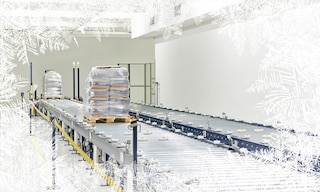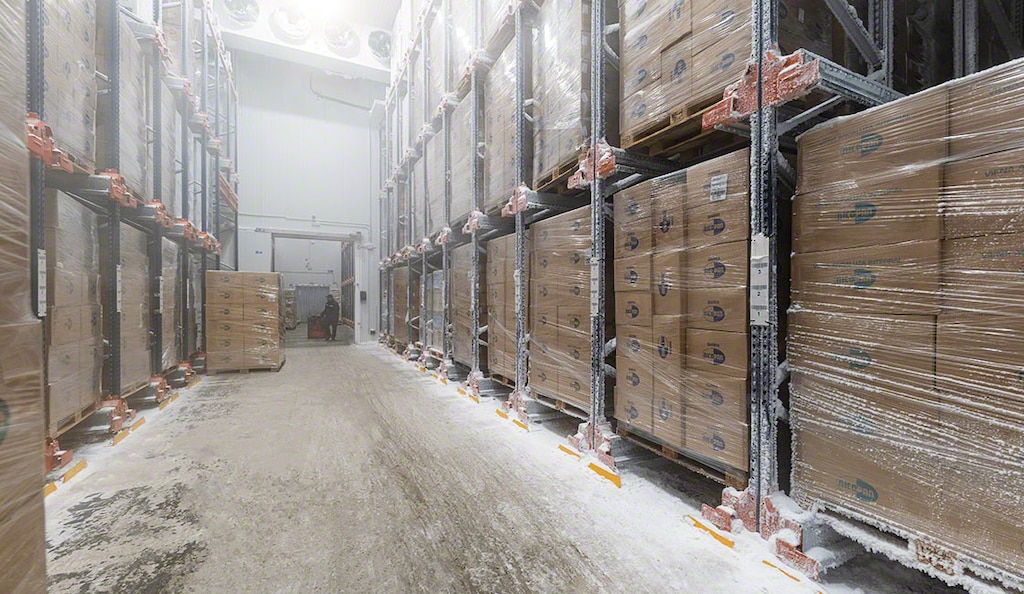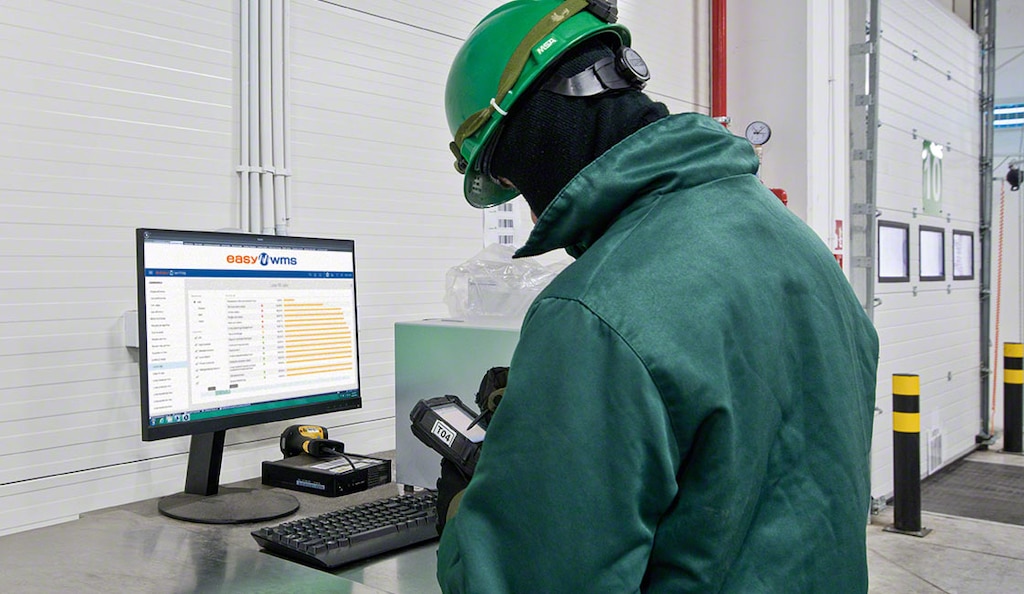
Tunnel freezer: definition, characteristics, and applications in logistics
A tunnel freezer (or freezing tunnel) freezes products speedily and uniformly in a controlled environment. This industrial machinery has become essential in the production chains of food-sector companies dedicated to meat, fish and seafood, ready meals, and frozen vegetables.
Various types of tunnel freezers cater to different situations and needs. All ensure that food is frozen rapidly, helping to maintain its quality and freshness. Below, we delve into what industrial freezing tunnels are, their characteristics, and how to apply them in logistics.
What is a tunnel freezer?
A tunnel freezer (also known as a freezing tunnel) is an industrial device designed to freeze products quickly and evenly. It consists of a sealed chamber into which the food products are placed. They move through the tunnel by means of a conveyor belt system. Inside the chamber, cold air currents are generated to freeze the food items in a very short time, ordinarily within minutes.
Freezing tunnels are commonly employed in the cold storage industry. In this growing sector, it’s crucial to reduce product temperatures swiftly to preserve the quality of the goods.
Characteristics of a tunnel freezer
The following are the main characteristics of a freezing tunnel:
- Continuous transport. In a tunnel freezer, products are moved nonstop through a series of conveyor belts or trays, providing a constant flow of goods.
- Extremely low temperatures. The tunnels are designed to reach subzero temperatures, below -1 ºF as a rule and even much colder in some cases.
- Cold airflow. Inside the tunnel, a cooling system is used to circulate cold air at high speed to cool and freeze products uniformly.
- Precise control of speed and time. It’s possible to adjust the conveyor belt speed and the time the goods spend in the tunnel. This allows businesses to control the freezing process according to the specific requirements of their products.
- Reduction of ice crystal formation. Rapid freezing in a tunnel freezer minimizes the formation of large ice crystals in goods, which could negatively affect their texture and quality.

Types of freezing tunnels
Depending on the freezing method used, tunnel freezers can be categorized into two basic types:
- Blast. In these tunnels, cold air is generated by compressors and distributed through fans. They’re suitable for freezing a wide variety of foods, e.g., meat, fish, fruits, vegetables, dairy products, and more.
- Contact (plate). In these freezers, food is frozen by coming into contact with a cold surface area, such as a metal plate or a roller. They’re apt for freezing products like baked goods, pastries, and ice cream quickly and evenly.
In addition to these two varieties, there are other types of tunnel freezers:
- Spiral. These freezers are formed by a spiral conveyor belt that moves products upwards or downwards in a spiral path as they pass through the chamber. Their spiral design takes up less space and offers greater freezing capacity in a reduced footprint. They’re commonly used in the bakery industry and the production of processed foods.
- Cryogenic. In a cryogenic tunnel freezer, foods are frozen using cryogenic gases such as liquid nitrogen or liquid carbon dioxide. This type of tunnel is fit for freezing delicate foods like fruits and vegetables.
- IQF. In an individual quick freezing (IQF) tunnel freezer, products are exposed to a high-speed cold airflow, resulting in fast, uniform freezing. These freezers are perfect for freezing more sensitive products like pizza and hamburgers.
Choosing your ideal tunnel freezer will depend on factors such as the type of food you work with, the amount to be frozen, and your available budget.
Differences between a freezing tunnel and a cold store
Cold storage rooms and tunnel freezers serve the same purpose: to house and preserve products at low temperatures. However, there are significant differences in their design and operation.
- Freezing vs. temperature maintenance. A tunnel freezer is used to freeze goods rapidly, taking them from ambient to subzero temperatures in a short period. In contrast, the primary function of a cold store is to maintain products at a low and constant temperature — usually above the freezing point — to extend their shelf life and keep them fresh.
- Freezing vs. cooling. Tunnel freezers normally operate at temps below -1 ºF for rapid freezing of goods. Cold storage rooms, on the other hand, tend to be kept above 32 °F (generally 32 °F to 41 °F, in line with the products stored).
- Short term vs. long term. Freezing tunnels are designed to freeze goods in a short period — often in a matter of minutes or hours — as per the product type and the machine’s capacity. Cold storage rooms lend themselves more to long-term storage since they run at a constant temperature, preserving product quality.
- Tunnel vs. cold store. Tunnel freezers are long, narrow structures through which products are transported on a conveyor belt or trays. Cold storage rooms are typically thermally insulated rooms with cooling units kept at a constant temperature. Products are stored inside the room on cold store racking.
Ultimately, the fundamental difference between a cold storage room and a freezing tunnel lies in their function and operating temperature. Both industrial structures play a key role in the supply chain of sectors requiring controlled temperatures, such as the food, pharma, and chemical industries.
Application of a tunnel freezer in logistics
Freezing tunnels are a vital part of cold chain logistics for organizations that manage products at subzero temps. Breaking the cold chain can have adverse consequences, such as the early deterioration of the goods, the loss of their sensory properties, and/or the proliferation of bacteria and microorganisms harmful to humans.
One example of a business that uses this kind of freezing system is 3PL provider Megafin. The company has 3 rapid freezing tunnels for managing a broad array of products, including poultry, pork, ice cream, vegetables, and pulps, among others. These goods are eventually shipped to over 30 clients in Colombia. The main challenge for this logistics provider is to store each item at the correct temperature and distribute it at the right time.
Every day, the Megafin warehouse receives a multitude of pallets containing a diverse range of food products sent by its clients. Most goods are moved directly to storage rooms, while others are assigned to 1 of the 3 tunnel freezers. Each has the capacity to freeze 7.7 to 13.2 tons of food at -22 °F within a period of 12 to 36 hours based on the product’s diameter and physical-chemical composition.
Easy WMS, the warehouse management system from the Mecalux Group, carefully tracks the pallets received. Moreover, it determines the appropriate location for each one, allocating it to frozen, refrigerated, or ambient-temperature storage. “One of the major advantages of digitalizing our logistics processes is the proper organization of the goods. Easy WMS assigns each pallet a location taking into account factors such as food type and required temperature. Some pallets can’t be stored together: we have to respect the regulations and specifications of each product to ensure the implementation of our food safety programs, HACCP system, and allergen control,” says Rogelio Betancourth, Logistics Manager at Megafin.

Tunnel freezer: an asset for cold chain logistics
If logistics is becoming increasingly demanding, it is even more so for companies that handle frozen products. Guaranteeing the traceability of items sensitive to temperature changes is critical for keeping them in optimal conditions. Cold chain logistics presents 2 additional challenges. The first is maintaining the cold chain without a substantial increase in energy consumption. The second is limiting workers’ exposure to subzero temperatures. Tunnel freezers allow for rapid freezing of food, preserving its quality without the need for human intervention.
The market offers multiple logistics solutions that streamline tasks for businesses dealing with frozen products and prevent interruptions in the cold chain. Looking to optimize your freezer warehouse? Be sure to get in touch. One of our expert consultants will be happy to advise you on the best option for your company.
